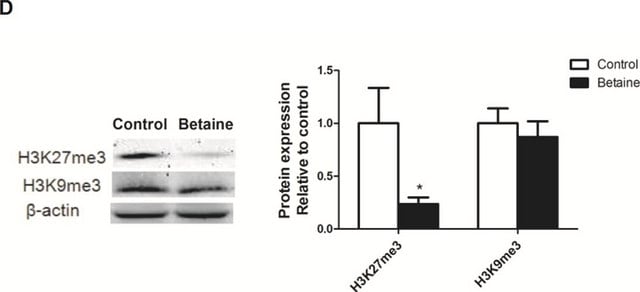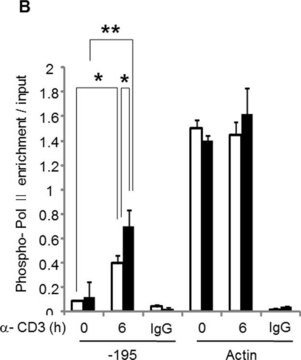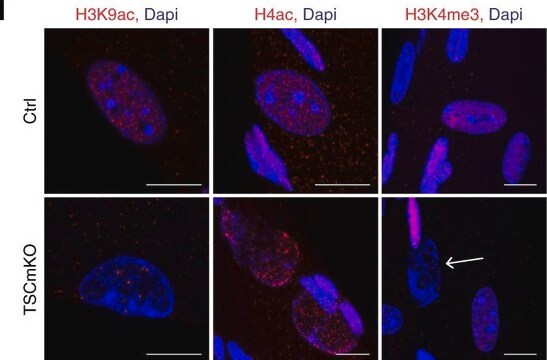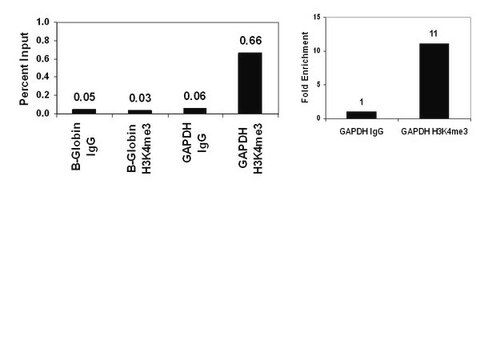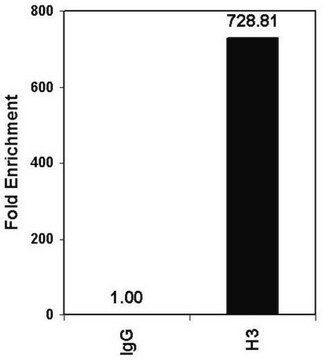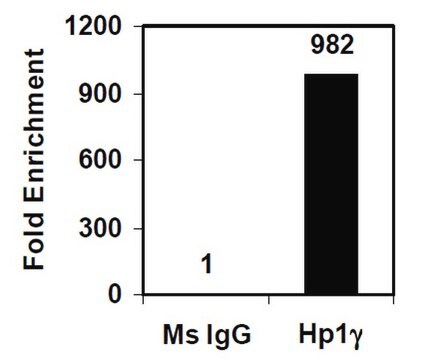17-683
ChIPAb+ Acetyl-Histone H3 (Lys27) - ChIP Validated Antibody and Primer Set
clone CMA309, from mouse
Synonym(s):
H3K27Ac, Histone H3 (acetyl K27), Histone H3K27Ac
Sign Into View Organizational & Contract Pricing
All Photos(2)
About This Item
UNSPSC Code:
12352203
eCl@ss:
32160702
NACRES:
NA.32
Recommended Products
biological source
mouse
Quality Level
antibody form
purified immunoglobulin
clone
CMA309, monoclonal
species reactivity
vertebrates, human
manufacturer/tradename
ChIPAb+
Upstate®
technique(s)
ChIP: suitable
immunoprecipitation (IP): suitable
western blot: suitable
isotype
IgG
NCBI accession no.
shipped in
dry ice
General description
All ChIPAb+ antibodies are individually validated for chromatin precipitation, every lot, every time. Each ChIPAb+ antibody set includes control primers (tested every lot by qPCR) to biologically validate your IP results in a locus-specific context. The qPCR protocol and primer sequences are provided, allowing researchers to validate ChIP protocols when using our antibody in their chromatin context. Each set also includes a negative control antibody to ensure specificity of the ChIP reaction.
The ChIPAb+ Acetyl-Histone H3 (Lys27) set includes the Anti-acetyl-Histone H3 (Lys27) antibody, a negative control antibody (purified Mouse IgG), and qPCR primers which amplify a 178 bp region within the promoter of the human RPL10 gene. The acetyl-histone H3 (Lys27) and negative control antibodies are supplied in a scalable "per ChIP" reaction size and can be used to functionally validate the precipitation of acetyl-histone H3 (Lys27)-associated chromatin.
The ChIPAb+ Acetyl-Histone H3 (Lys27) set includes the Anti-acetyl-Histone H3 (Lys27) antibody, a negative control antibody (purified Mouse IgG), and qPCR primers which amplify a 178 bp region within the promoter of the human RPL10 gene. The acetyl-histone H3 (Lys27) and negative control antibodies are supplied in a scalable "per ChIP" reaction size and can be used to functionally validate the precipitation of acetyl-histone H3 (Lys27)-associated chromatin.
Lysine acetylation is a dynamic, reversible and tightly regulated protein and histone modification that plays a major role in chromatin remodeling and in the regulation of gene expression in various cellular functions. Histone acetylation is often associated with transcriptional activation and acetylation of H3K27 is found at active enhancers.
The previously assigned protein identifier Q66I33 has been merged into P84243. Full details can be found on the UniProt database.
Specificity
Recognizes histone H3, Mr 17 kDa, acetylated at Lys27.
This peptide sequence is identical in a wide range of animal and plant species.
Immunogen
Epitope: a.a. 19-37
The acetyl-histone H3 (Lys27) purified antibody is made against a synthetic peptide (acetylated at Lys27) corresponding to amino acids 19-37 of histone H3.
Application
Acetyl-Histone H3 (Lys27) ChIP validated antibody & primer set including the ChIP-grade antibody & the specific control PCR primers used for chromatin immunoprecipitation of H3K27Ac.
Chromatin Immunoprecipitation:
Sonicated chromatin prepared from HeLa cells (1 X 106 cell equivalents per IP) was subjected to chromatin immunoprecipitation using 2 µg of either a normal mouse IgG or Anti-acetyl-Histone H3 (Lys27) antibody and the Magna ChIP G (Cat. #17-611) Kit. Successful immunoprecipitation of acetyl-histone H3 (Lys27)-associated DNA fragments was verified by qPCR using β-globin Promoter ChIP Primers versus RPL10 Promoter Primers (Please see figures). Data is presented as percent input of each IP sample relative to input chromatin for each amplicon and ChIP sample as indicated.
Please refer to the EZ-Magna G ChIP (Cat. #17-408) or EZ-ChIP (Cat. #17-371) protocol for experimental details.
Western Blot Analysis:
Acid extracts from untreated (Lane 1) and sodium-butyrate treated (Lane 2) HeLa cells were resolved by electrophoresis, transferred to PVDF membrane and probed with Anti-acetyl Histone H3 (Lys27), clone CMA309 (0.1 μg/mL). Proteins were visualized using a goat
anti-mouse secondary antibody conjugated to HRP and a chemiluminescence detection system (Please see figures).
Sonicated chromatin prepared from HeLa cells (1 X 106 cell equivalents per IP) was subjected to chromatin immunoprecipitation using 2 µg of either a normal mouse IgG or Anti-acetyl-Histone H3 (Lys27) antibody and the Magna ChIP G (Cat. #17-611) Kit. Successful immunoprecipitation of acetyl-histone H3 (Lys27)-associated DNA fragments was verified by qPCR using β-globin Promoter ChIP Primers versus RPL10 Promoter Primers (Please see figures). Data is presented as percent input of each IP sample relative to input chromatin for each amplicon and ChIP sample as indicated.
Please refer to the EZ-Magna G ChIP (Cat. #17-408) or EZ-ChIP (Cat. #17-371) protocol for experimental details.
Western Blot Analysis:
Acid extracts from untreated (Lane 1) and sodium-butyrate treated (Lane 2) HeLa cells were resolved by electrophoresis, transferred to PVDF membrane and probed with Anti-acetyl Histone H3 (Lys27), clone CMA309 (0.1 μg/mL). Proteins were visualized using a goat
anti-mouse secondary antibody conjugated to HRP and a chemiluminescence detection system (Please see figures).
Research Category
Epigenetics & Nuclear Function
Epigenetics & Nuclear Function
Research Sub Category
Chromatin Biology
Chromatin Biology
Packaging
25 assays per kit, ~2μg per chromatin immunoprecipitation
Quality
Chromatin Immunoprecipitation:
Sonicated chromatin prepared from HeLa cells (1 X 106 cell equivalents per IP) were subjected to chromatin immunoprecipitation using 2 µg of either a normal mouse IgG or Anti-acetyl-Histone H3 (Lys27) antibody and the Magna ChIP G (Cat. #17-611) Kit.
Successful immunoprecipitation of acetyl-histone H3 (Lys27) associated DNA fragments was verified by qPCR using ChIP Primers RPL10 Promoter (Please see figures).
Please refer to the EZ-Magna G ChIP (Cat. #17-409) or EZ-ChIP (Cat. #17-371) protocol for experimental details.
Sonicated chromatin prepared from HeLa cells (1 X 106 cell equivalents per IP) were subjected to chromatin immunoprecipitation using 2 µg of either a normal mouse IgG or Anti-acetyl-Histone H3 (Lys27) antibody and the Magna ChIP G (Cat. #17-611) Kit.
Successful immunoprecipitation of acetyl-histone H3 (Lys27) associated DNA fragments was verified by qPCR using ChIP Primers RPL10 Promoter (Please see figures).
Please refer to the EZ-Magna G ChIP (Cat. #17-409) or EZ-ChIP (Cat. #17-371) protocol for experimental details.
Target description
~17 kDa
Physical form
Anti-acetyl-Histone H3 (Lys27) (mouse monoclonal IgG1, Clone CMA309). One vial containing 50 μg of protein G purified antibody in 50 μL PBS containing 0.05% sodium. Store at -20°C.
Normal Mouse IgG. Two vials containing 25 μg purified Mouse IgG in 25 μL storage buffer containing 0.1% sodium azide. Store at -20°C.
ChIP Primers, RPL10 Promoter. One vial containing 75 μL of 5 μM of each primer specific for the promoter region of human RPL10. Store at -20°C.
FOR: ACC CGT CTT CGA CAG GAC T
REV: GGA ACG GAA GAC GAG AAC AG
Normal Mouse IgG. Two vials containing 25 μg purified Mouse IgG in 25 μL storage buffer containing 0.1% sodium azide. Store at -20°C.
ChIP Primers, RPL10 Promoter. One vial containing 75 μL of 5 μM of each primer specific for the promoter region of human RPL10. Store at -20°C.
FOR: ACC CGT CTT CGA CAG GAC T
REV: GGA ACG GAA GAC GAG AAC AG
Format: Purified
Storage and Stability
Stable for 1 year at -20°C from date of receipt. Aliquot upon thawing, avoid freeze thaw cycles.
Analysis Note
Control
Included negative control mouse IgG antibody and control primers specific for human RPL10 promoter.
Included negative control mouse IgG antibody and control primers specific for human RPL10 promoter.
Legal Information
UPSTATE is a registered trademark of Merck KGaA, Darmstadt, Germany
Disclaimer
Unless otherwise stated in our catalog or other company documentation accompanying the product(s), our products are intended for research use only and are not to be used for any other purpose, which includes but is not limited to, unauthorized commercial uses, in vitro diagnostic uses, ex vivo or in vivo therapeutic uses or any type of consumption or application to humans or animals.
Storage Class Code
10 - Combustible liquids
Certificates of Analysis (COA)
Search for Certificates of Analysis (COA) by entering the products Lot/Batch Number. Lot and Batch Numbers can be found on a product’s label following the words ‘Lot’ or ‘Batch’.
Already Own This Product?
Find documentation for the products that you have recently purchased in the Document Library.
Marta Kubiak et al.
International journal of molecular sciences, 20(2) (2019-01-13)
The long-range control of gene expression is facilitated by chromatin looping and can be detected using chromosome conformation capture-3C. Here we focus on the chromatin architecture of the PTBP3 (Polypyrimidine tract binding protein 3) locus to evaluate its potential role
Katherine A Pillman et al.
Nucleic acids research, 47(16), 8606-8619 (2019-08-03)
Epithelial-mesenchymal transition (EMT) has been a subject of intense scrutiny as it facilitates metastasis and alters drug sensitivity. Although EMT-regulatory roles for numerous miRNAs and transcription factors are known, their functions can be difficult to disentangle, in part due to
Akua Yalley et al.
The Journal of biological chemistry, 291(16), 8848-8861 (2016-03-02)
FoxO1 binds to insulin response elements located in the promoters of insulin-like growth factor-binding protein 1 (IGFBP1) and glucose-6-phosphatase (G6Pase), activating their expression. Insulin-mediated phosphorylation of FoxO1 promotes cytoplasmic translocation, inhibiting FoxO1-mediated transactivation. We have previously demonstrated that FoxO1 opens
Yavor K Bozhilov et al.
Nature communications, 12(1), 3806-3806 (2021-06-23)
Many single nucleotide variants (SNVs) associated with human traits and genetic diseases are thought to alter the activity of existing regulatory elements. Some SNVs may also create entirely new regulatory elements which change gene expression, but the mechanism by which
Jesús Duque-Afonso et al.
Cancer research, 78(22), 6497-6508 (2018-09-29)
Dasatinib is a multi-tyrosine kinase inhibitor approved for treatment of Ph+ acute lymphoblastic leukemia (ALL), but its efficacy is limited by resistance. Recent preclinical studies suggest that dasatinib may be a candidate therapy in additional ALL subtypes including pre-BCR+ ALL.
Our team of scientists has experience in all areas of research including Life Science, Material Science, Chemical Synthesis, Chromatography, Analytical and many others.
Contact Technical Service